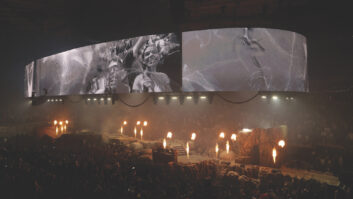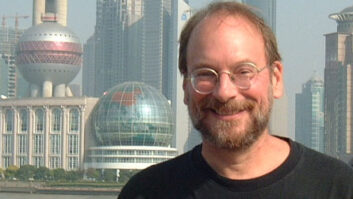Although filming was completed before September 11, one might have expected some concerns at Paramount Pictures about the release of The Sum of All Fears and its story, in which terrorists, determined to provoke worldwide war, detonate a nuclear warhead during the Super Bowl. But, according to director Phil Alden Robinson, no such debate occurred. A writer himself whose previous directing credits include Field of Dreams, Sneakers and an episode of HBO’s World War II epic Band of Brothers, Robinson was able to take Sum beyond standard summer thriller into multidimensional experience, with an ending that some have called inspirational.
In spite of its status as a big Tom Clancy movie featuring Ben Affleck and Morgan Freeman, Sum‘s budget wasn’t extravagant. Location effects recording wasn’t an option, so every sound — the flyover of troop-carrying helicopters, emphatic footsteps into a Russian president’s hushed bedroom, and locations from the streets of Vienna and Washington, D.C., to the countrysides of Russia and Virginia, as well as a nuclear explosion and its aftermath — had to be created from scratch. Fortunately, supervising sound editor John Leveque is a partner at Soundstorm, with its enormous library of sounds collected over the years for such films as L.A. Confidential, Batman Forever and The Fugitive.
“It’s enhanced reality, cheated reality,” comments dialog/ADR supervisor Kimberly Voigt. “Phil has a particular gift for making strange things work. When a bomb is found in the desert, someone puts a hand under it searching for the fuse. But it’s a nuclear bomb; there is no fuse. Phil wanted the sound of flies buzzing because it’s evil and weird, and in the temp, it actually was flies. It got more sophisticated in the final, but it’s based on flies buzzing and it gives the sense of evil that he was after.”
A major challenge was Robinson’s determination to avoid ADR. “I programmed 220 lines of ADR and we got to do 90 of them,” says Voigt. “Most actors and directors prefer to avoid ADR, but Phil is on the extreme side. We did the things that we absolutely had to — that was it. I’ve been thanking my lucky stars that we have [dialog mixer] Chris Jenkins.”
“In a special effects movie like this, with heavy equipment and machines, it’s especially difficult to make production sound work,” adds Leveque. “When you do, there’s much more sense of reality. For example, there’s a scene where soldiers arrive to rescue the president; that had real helicopters and real Marines and you can feel it.”
Voigt, who handled both ADR and dialog supervision, found Pro Tools a boon for melding tiny bits of ADR with production dialog. “My favorite thing about being digital is that I have the whole movie in different versions,” she explains. “I can create hybrids. For example, we had a line of ADR because one of the actors had mispronounced a Russian name. I was able to just take the little piece I needed and cut it into the dialog track.”
During the final mix on Universal Studios’ Hitchcock Stage, a conscious effort was made to keep levels reasonable, resulting in a mix that avoids the problem of digital harshness that’s endemic to recent action movies. “Of course, loudness has an emotional effect,” says Leveque, “but often it’s detail, rather than loudness, that makes it exciting. When Jack Ryan is inside the helicopter getting thrown around, if you can hear the detail — things hitting the walls, alarms going off, all the components — you’ve achieved something more real. Fortunately, [effects mixer] Frank Montano is also very much in that mode.”
The veteran members of Leveque’s sound team concur that The Sum of All Fears was an unusual project. “There was an inspiring nature about this movie,” states co-supervising sound editor Anthony Milch. “Not only because of its content, but because of the director’s skill. It’s not overworked or preachy, but the socially relevant issues come through.
“In our work, we often try to remember what we felt the first time we saw a film, to re-create that experience. You want to keep your focus on that emotion to heighten with the sound what the director has already provided. At the first screening of this film, a lot of us were noticeably touched. When you’re lucky enough to work with a team of people who really care, the end result can be far in excess of the actual work that was done. I think that’s what happened here.”





